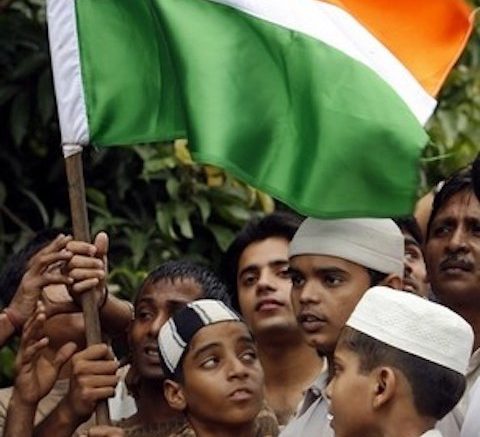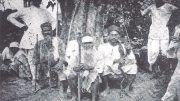Muslims, in turn, regard it as “communal” (anti-Islamic), citing, among other things, its role in pulling down the historic Babri Masjid in Ayodhya in northern India in 1992 to build a temple dedicated to Lord Ram in its place. The demolition of the mosque, in the full glare of television cameras while the government looked on, was a turning point in Hindu-Muslim relations, and its bitter legacy lingers on.
More ominously for Muslims in the event of a BJP victory, the new government will be headed by Narendra Modi, the chief minister of Gujarat, on whose watch hundreds – some say thousands – of Muslims were killed in 2002 in one of the worst anti-Muslim riots in independent India. A self-avowed “proud Hindu nationalist”, as he described himself in a recent interview with Reuters, Modi is accused of “initiating” and “condoning” the violence and is facing court cases. He is still banned from entering the United States for his alleged role in the riots.
Understandably, Muslims are on tenterhooks at the prospect of his premiership. However, it is also the case that quite a few Muslims plan to vote for the BJP for purely pragmatic reasons. They reckon that it is safer to go with the tide given that, ultimately, they have to “live with” the BJP and Modi. Sleeping with the “enemy” is their way of buying security.
This trend is a significant break with the past, when Muslims were guided more by emotions and ideological factors than practical considerations. The new Muslim mantra is: go where you get the best value for your vote irrespective of the colour of their politics. A smart strategy that is likely to break the notion of a Muslim “vote bank” that previously allowed supposedly secular parties, especially the ruling Congress party, to take their support for granted by exploiting their fears about the BJP.
Meanwhile, the same sort of pragmatism is driving a broader and more profound change in the Muslim mood, which is the theme of my book. A “quiet revolution” in Muslim thinking is brewing, driven by a young generation that believes that the community has had enough of what the writer Salman Rushdie has called the “politics of grievance”.
For the first time since independence more than 65 years ago, Muslims are starting to recognise that, for far too long, they have sought to present themselves as victims of solely external factors, such as institutional state bias and Hindu communalism, while failing to reflect on their own role in the community’s social and economic stagnation.
According to the report of an independent commission set up by the government, Muslims are at the bottom of the heap on almost every single social indicator. It is the result of a combination of reasons, including state-backed anti-Muslim bias. But, more importantly, it has a lot to do with the community’s own misplaced priorities.
For most of the past six decades, the Muslim agenda has focused largely on issues relating to their religious and cultural identity, such as the right to be governed by Islamic laws in matters of marriage, divorce and inheritance, etc, to the exclusion of more pressing development issues. But, as I point out in my book, that is changing, with young Muslims determined to move the community away from purely sectarian concerns on to the more secular bread-and-butter terrain.
A leadership crisis has dogged Muslims since the Partition in 1947, when the cream of Muslim society migrated to Pakistan. This created a vacuum that allowed a cabal of small-time, self-serving Muslim politicians and mullahs to step in and hijack the community’s leadership. Their agenda was simple: exploit its insecurities to get the vote by claiming to “protect” it from its Hindu “enemies”. They developed a vested interest in keeping the community backward so that it did not ask any awkward questions.
Gradually, Muslims withdrew into a shell and became isolated from the rest of Indian society. This fed into the right-wing Hindu campaign portraying Muslims as “insular” and unwilling to join the “national mainstream”. Young Muslim reformers are as critical of the Muslim right as they are of the Hindu right, both of which have been feeding on each other to create a climate of mutual suspicion and hate. They say they want to draw a line under the past, rid the community of its self-styled leaders and concentrate on issues that affect everyday lives.
Notably, it is the young women, often dressed in hijabs, who are driving the change. Contrary to the stereotyped image of the Muslim woman, they are educated, articulate, conscious of their rights and have aspirations that are no different from those of any other modern Indian woman.
In a sense, Indian Muslims are having their own “spring”. It may not have the shape of an organised movement, and people are not going around waving banners, but it is genuine, widespread, and it looks like it is here to stay.
Excerpts from India’s Muslim Spring: Why is Nobody Talking About It? by Hasan Suroor
Let me confess that this is not the book I set out to write. The book I had in mind was about the unchanging face of Muslim fundamentalism in India. But barely a few weeks into research, I discovered that I was completely on the wrong track. The big story staring me in the face was quite the opposite – that is, far from flourishing, Muslim fundamentalism was actually dying a slow death. As I travelled across the country and spoke to people, I found that, over the past decade (the period when I had been away from India), there had been a profound change in the Muslim mindset. Today’s Indian Muslim, I discovered, was altogether a different species – educated, aware, wiser, less sectarian and more pragmatic – than the one I had known for much of my life.
Away from the sensational headlines about Islamic extremism, a quiet revolution is taking place. The Muslim discourse has moved on from an obsessive focus on sectarian demands (does anyone remember the last big debate on Muslim Personal Law, for example?) to the more secular bread-and-butter issues. Where once the dinner table talk in Muslim households was unremittingly negative and pessimistic (it was all about how Muslims were being “crushed” and trampled upon, and had no future in India), today it is about change and looking forward.
≥≥≥
There is a new generation of Muslims who want to rid the community of its insular and sectarian approach by concentrating on things that affect their everyday lives: education, jobs, housing, security. They despair of mullahs and self-styled Muslim “leaders”. And they speak a language that is modern and forward-looking. Their interpretation of Islam stresses inclusion and tolerance. They abhor the use of violence in the name of Islam.
≥≥≥
Living through the worst phase of Indian Muslim fundamentalism from the 1970s through to the 1990s, I never thought I would live to write its obituary. The depressing prospect of having to live the rest of my life in a climate of competitive Muslim-Hindu fundamentalism, feeding on each other in a toxic double act, was one reason why, at an age when many migrants contemplate returning home, I decided to take a break from India and moved to Britain. I simply couldn’t take it anymore.
At one extreme, there was the creeping Hindutva-isation of India, with a resurgent Hindu Right flexing its muscles, and at the other, a wave of Muslim fundamentalism dragging the whole community deeper and deeper into a long, dark tunnel of isolation, at the end of which there appeared to be no light. Their actions reinforced the image of Muslims as a backward, intolerant and insular community that refuses to join the national mainstream. With such friends, Muslims didn’t need external enemies. It did their work for them. The Babri Masjid fiasco was as much the doing of chest-thumping Muslim “leadership” as it was a calculated act by the right-wing Hindu middle class, to humiliate Muslims.
Arbitrary fatwas based on the most regressive of interpretations of Islam were commonplace. I heard of more fatwas in the 1990s than I had in the previous half century. Those who didn’t agree with the fundamentalist view were denounced, portrayed as wardrobe ‘RSS [a right-wing Hindu nationalist organisation] stooges’, and hounded. That was then. A decade later, there is a sea change, thanks to the coming of age of a new generation of Muslims – less excitable and wiser – having learnt from the follies of their predecessors. And certainly more realistic about their place in a Hindu-majority India. All you need to do is to get out a bit more, talk to people, listen to the voices around you, and you’ll discover how refreshing the air smells today than it did all those years ago.
≥≥≥
An outsider just arrived in AMU [Aligarh Muslim University] is likely to be misled by the sight of hijab and burqa-clad young women into believing that they are a conservative, backward-looking bunch.
But most are highly independent, articulate and more liberal than many of their male peers. In fact, my research tells me that the average Indian Muslim woman today is generally more progressive than the average Muslim man.
At AMU, I found that, almost on every issue of significance – from the , author of India’s Muslim Spring In of identity and fundamentalism to how they saw their place in India – there were many more female liberal voices compared to men.
In group discussions, men had a rough time, as women robustly challenged their views. Their claims about Islamic dress code for women were greeted with furious accusations of self-serving, selective interpretation of Islamic injunctions.
At one such gathering, when a young attendee, Ahmar Afaq Ali, a law student, said that it was compulsory in Islam for all women who regarded themselves as “good Muslims” to wear hijab, he was bombarded with questions about his knowledge and understanding of Islam. “Where did you read this?” retorted Saima Kareem, an undergraduate. “All that Islam says is that women should dress modestly, but it doesn’t lay down a dress code. It is men and the mullahs who keep telling us what to wear. Islam doesn’t say that you stop being a good Muslim if you don’t wear hijab or show off your so-called Muslim identity. I am no less a Muslim than those who wear hijab or burqa.”
≥≥≥
It was not only in relation to their own personal freedoms that these girls so boldly and articulately challenged the boys. They took them on over a whole range of issues affecting Muslims – the real reasons for their educational and economic backwardness; the persecution complex they suffered from; their understanding of secularism and their future in India.
As someone who has reported about AMU for some 30 years, on and off, I noticed a massive change in the attitude of its women students.
Not only are today’s female students more progressive in their outlook, they are willing to speak their mind in public. Rewind to 20 years ago, and they would have raged privately, boiled with impotent anger, but they would not have had the courage to speak up.
≥≥≥
Over the years, the so-called ‘Muslim debate’ has polarised around two extreme viewpoints – the fundamentalists at one end of the extreme and left-wing progressives on the other, both talking ‘at’ each other rather than to the broader community.
In the process, the centrist viewpoint, which is what the majority of Muslims hold, has been lost. Political parties must seek out moderate young Muslims and groom them in leadership roles. If the political class and the media do their bit, Indian Muslims can look forward, finally, to be led by people who can take them in the right direction. Just as it is true of a nation, so it is of a community, that it is only as good as its leadership.
Even as I am optimistic about the future of Indian Muslims, history cautions us against jumping the gun too soon. The most promising of revolutionary movements have fizzled out while our ‘Muslim spring’ has not even taken the form of an organised movement yet. The only thing that can be said with certainty at this stage is that things cannot get worse than they have been so far. When you start from such a low base, they can only get better.
• Extracts taken from India’s Muslim Spring – Why is Nobody Talking about It? Hasan Suroor (Rupa Publications, Dh145).
Read more: http://www.thenational.ae/arts-culture/author-hasan-suroor-young-muslims-leading-quiet-revolution-in-india#full#ixzz2tDz2ock9





Be the first to comment on "Young Muslims leading quiet revolution in India"